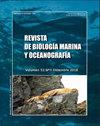Ontogenetic differences in muscle fatty acid profile of white sharks Carcharodon carcharias off Guadalupe Island, México
IF 0.5
4区 生物学
Q4 MARINE & FRESHWATER BIOLOGY
引用次数: 2
Abstract
Carcharodon carcharias is a protected species occupying the apex of most marine foodwebs where they are present. Aggregation areas, such as Guadalupe Island, Mexico, that have been related to feeding events, are of special interest for this species conservation. The aim of this study was to describe the fatty acid profile of C. carcharias ' muscle for the first time on Guadalupe Island, using non-lethal biopsy methods to determine ontogenetic and sex differences in relation to diet and habitat use. Fatty acid profiles and biomarkers from different individuals are explored as a source of integrated information of their diet. Analysis of the fatty acid composition of individuals with varying total lengths (2.3-5.0 m) suggested a dietary shift between juveniles and adults occurring at aproximately 3 m. Fatty acid biomarkers indicated a higher degree of carnivorism in adults than in juveniles. Additionally, these ecological tracers suggested that juveniles feed in shallow waters close to the coast, while adults feed in deep waters along inshore and offshore areas. This study represents a first step towards using fatty acid composition as a relevant tool for further understanding dietary shifts and habitat use throughout the ontogeny of C. carcharias . However, to corroborate this, further studies with larger sample sizes are required.瓜达卢佩岛外白鲨肌肉脂肪酸谱的个体发生差异
Carcharodon carcharias是一种受保护的物种,占据了大多数海洋食物网的顶端。聚集区,如墨西哥瓜达卢佩岛,与觅食事件有关,对该物种的保护特别感兴趣。本研究的目的是首次在瓜达卢佩岛上描述C.carcharias肌肉的脂肪酸图谱,使用非致命活检方法来确定与饮食和栖息地使用相关的个体遗传和性别差异。不同个体的脂肪酸图谱和生物标志物被探索作为他们饮食的综合信息来源。对不同总长度(2.3-5.0米)个体的脂肪酸组成的分析表明,青少年和成年人之间的饮食变化发生在大约3米处。脂肪酸生物标志物表明,成年人的食肉程度高于青少年。此外,这些生态示踪剂表明,幼年鱼在靠近海岸的浅水区觅食,而成年鱼在近海和近海的深水区觅食。这项研究代表着利用脂肪酸成分作为相关工具,进一步了解卡氏锥虫个体发育过程中的饮食变化和栖息地使用的第一步。然而,为了证实这一点,还需要进行更大样本量的进一步研究。
本文章由计算机程序翻译,如有差异,请以英文原文为准。
求助全文
约1分钟内获得全文
求助全文
来源期刊
CiteScore
0.70
自引率
0.00%
发文量
41
审稿时长
12 months
期刊介绍:
Publicar desde una perspectiva científica, artículos originales, decididos por un proceso de revisión por pares, invitando a expertos de reconocido prestigio en el área. Los trabajos publicados se caracterizarán por su solidez teórica-metodológica, actualidad y relevancia para las ciencias marinas.
Se reciben trabajos inéditos derivados de la investigación científica realizada en ambientes marinos y estuarios, en formato de Revisión, Artículos, Notas Científicas, y Obituarios en las siguientes disciplinas::
Biología-Ecología marina
Oceanografía física, química y biológica
Contaminación marina
Geología marina
Sistemática, Faunística y Biogeografía Marina
Manejo Costero
Acuicultura marina
Pesquería marina.

 求助内容:
求助内容: 应助结果提醒方式:
应助结果提醒方式:


